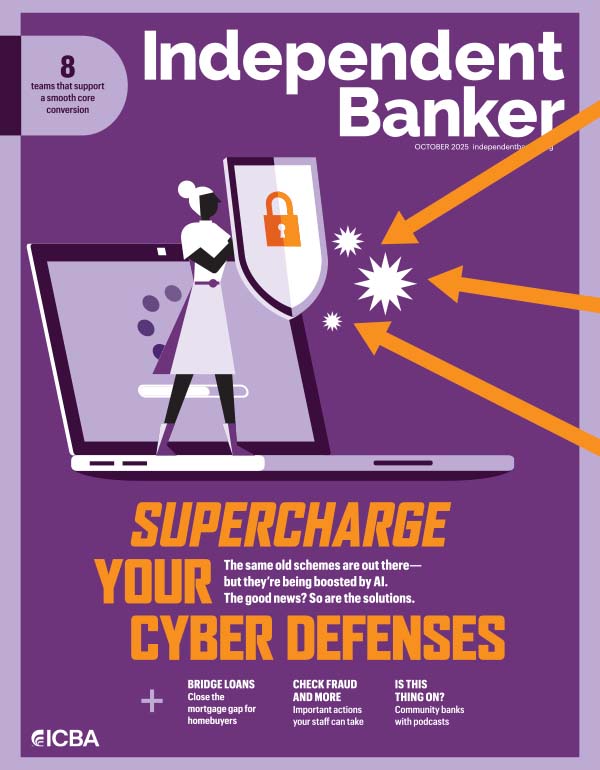Banks across the nation have heard about the prospective benefits of chatbots, which can engage with customers via text, a spoken conversation or sometimes both. In 2023, chatbot developer Agent IQ commissioned a study of 200 financial institutions in the U.S. and Canada. Of those surveyed, 96% said they would consider adopting AI-powered chatbots within the next 12 months.
One community bank that’s already there is $1.8 billion-asset CNB Bank & Trust, N.A. in Carlinville, Ill. Since it unveiled a chatbot feature for customers two years ago, the bank’s tellers are personally answering significantly fewer customer questions, potentially leading to an 80% reduction as more customers utilize the AI chatbot.
Cody Zellers, the community bank’s project coordinator, says routine inquiries fielded by CNB’s chatbot, Cashanova, range from “How do I order new checks?” to “Where do I go to sign up for a debit card?” Cashanova, Zellers says, is equipped to answer more than 600 basic banking questions, all of which have clear answers and don’t require a lengthy conversation.
AI’s inhuman capabilities
Jake Tyler, AI market lead at Glia, a customer interaction technology provider, says AI-driven chatbots don’t just free up overburdened staff; a chatbot can also answer basic questions outside of traditional banking hours. Across a large customer base, Tyler has seen AI chatbots contain roughly 65% of call and chat interactions, with strong levels of customer satisfaction and some appreciable cost savings.
Beyond giving employees more time to tackle complicated requests, chatbots possess other advantages that human beings can’t match. “The good news is that chatbots are very consistent,” says Tyler. “They don’t go to the bathroom, and they don’t sleep—and they can handle [over] a million interactions simultaneously.”
What’s more, an AI tool can amass a mindboggling quantity of knowledge. “Our AI customer-service agent is learning from more interactions in one month than a human will have in a lifetime,” says Tyler.
“We wanted customers to be able to self-service 24/7 if it’s a simple question they need answered.”—Jackie Verkuyl, BAC Community Bank
Chatbot duties vs. banker responsibilities
The advent of generative AI has employees across industries feeling uncertain about their job security, but Tyler rejects the either/or mentality that suggests chatbots inevitably mean less human interaction in banking. He maintains that both AI and human bankers have critical roles to play.
For instance, chatbots excel at responding to simple requests but can also help customers reach the right human being fast. “If you call up and say, ‘Hey, I want a million-dollar mortgage,’ then the bank wants to get you to its million-dollar mortgage specialist as quickly as possible, and chatbots can do that,” he says.
Charles Potts, ICBA executive vice president and chief innovation officer, takes a more cautious approach. He urges community bankers to remember the importance of the relationship-oriented value proposition they offer their customers. The last thing a community bank wants is for a chatbot to disintermediate a bank and its prized customer, says Potts. He argues that the best chatbots have the virtual equivalent of “an eject button”—an easy-to-find option for exiting automation and engaging with a human employee instead.
When $800 million-asset BAC Community Bank in Stockton, Calif., went live with Agent IQ’s chatbot solution in April 2022, it named the system “Smart ALAC,” an acronym for “All Access Connection.” From the very beginning, BAC used Smart ALAC not as an alternative to human-led customer service but as a method to differentiate between authenticated users who have logged in and anonymous users when engaging with the chatbot, explains Jackie Verkuyl, executive vice president.
Quick Stat
96%
of 200 U.S. and Canadian financial institutions claimed they would consider using AI-powered chatbots within 12 months.
Source: Agent IQ
“The bank wanted to take some volume off of our call center … and we wanted customers to be able to self-service 24/7 if it’s a simple question they need answered,” she says. Verkuyl notes that, as a matter of course, all BAC’s customers can create a login and select a dedicated personal banker for one-on-one support, while non-logged-in users can use the chat to connect with any available banker.
Javelin Strategy & Research analyst Kevin Libby advises community bankers to opt for rules-based chatbots when responding to customer questions. He notes that natural language processing programs capable of making inferences are terrific for interpreting customer questions, but answers provided by a bank should be carefully scripted to make sure any guidance is factually correct and not open to misinterpretation.
Here, Libby cites a recent loss by Air Canada in a small-claims court case in which the transportation giant’s chatbot hallucinated an answer inconsistent with airline policy about bereavement fares. Remember, he says, “once a bank has given [a customer] information in writing, it’s tough to pull back later.”
Is a chatbot worth it?
While chatbots have benefited many community banks, some small institutions have remained on the sidelines—with good reason, according to Glia’s Tyler. “If you’re very small and your interaction volume is very low, the juice may not be worth the squeeze,” he says.
Until recently, the clunkiness of commercial chatbots has also been a turnoff, says Tyler. He argues the latest technology is vastly improved: “We’ve arrived at an inflection point in which the next five to 10 years should be transformational.”
Community bankers themselves are advocating for a practical approach for introducing AI into customer service. “People in the banking world sometimes get a little bit standoffish when they hear words like ‘chatbot’ or ‘AI,’” says CNB’s Zellers. “Chatbots really can be used safely and securely. My advice is: Try chatbots for a while, see what works and then grow whatever works best.”






